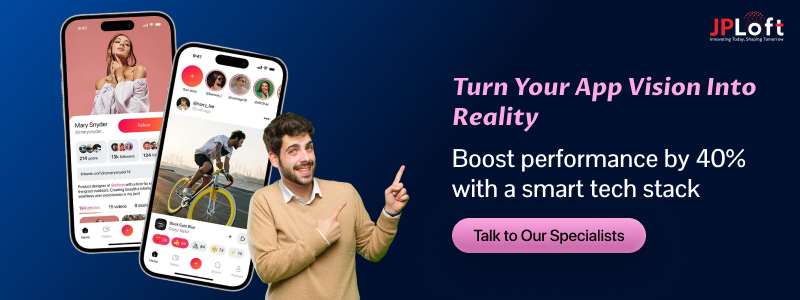Key Takeaways
Selecting the right social media app tech stack lays the foundation for scalability, performance, and long-term success.
A balanced combination of frontend, backend, and database technologies ensures a seamless and secure user experience.
A modern social media app tech stack combines React Native or Flutter for the frontend, Node.js or Django for the backend, and MongoDB or PostgreSQL for databases, supported by AI, ML, and NLP tools for personalization and scalability.
Integrating AI, ML, and NLP enhances personalization, engagement, and real-time content recommendations.
Continuous evaluation of emerging tools and frameworks keeps your app aligned with evolving user expectations and industry trends.
Partnering with JPLoft gives you access to seasoned app development experts who can help craft a scalable, high-performing tech stack designed to support your social media app’s long-term success.
In today’s hyper-connected world, social media platforms have evolved far beyond digital networking; they’re powerful ecosystems driving communication, commerce, and creativity.
But behind every successful platform lies a well-structured social media app tech stack, the backbone that defines performance, scalability, and user experience.
Whether you’re building a niche community app or a global platform, understanding the technology stack is crucial to ensure smooth functionality across devices and millions of active users.
Hence, the question arises “What is a suitable social media app tech stack?”
It typically includes React Native or Flutter for the frontend, Node.js or Django for the backend, and MongoDB or PostgreSQL for databases, supported by AI, ML, and NLP tools to deliver personalized, high-performing experiences.
This blog serves as a comprehensive guide to social media app tech stack, exploring everything you need to know about crafting a robust social media app tech foundation, from frameworks and tools to selection processes and expert insights, helping you make informed decisions before your next big app launch.
An Overview of Social Media App and Related Market Stats
Social media apps have become integral to how people connect, share, and consume content worldwide. However, launching a successful platform is not without hurdles.
Startups and enterprises must navigate social media app development challenges, such as ensuring data security, achieving scalability, and maintaining user engagement, all of which are critical for long-term success.
-
Around 6.04 billion people are active internet users globally, with social media usage growing steadily year over year.
-
The average daily time spent on social media is around 2 hours and 24 minutes per user, signaling high engagement potential.
-
Platforms with multimedia and real-time messaging features see 40–50% higher user retention rates than basic apps.
-
The global social media market is expected to exceed $1.2 trillion by 2027, driven by AI integration and mobile-first strategies.
Looking at the best social media apps can offer valuable insights into emerging trends, innovative features, and evolving user expectations. Leveraging a well-structured social media app tech stack ensures your platform can handle both current demand and future growth while supporting advanced features and seamless performance across devices.
Basics of Social Media App Tech Stack
A strong foundation is essential for any social media platform. The social media app tech stack determines how smoothly your app runs, how easily it scales, and how well it engages users.
Choosing the right technologies for frontend, backend, database, and mobile frameworks can make or break your platform.
Here are the key components of a social media app tech stack:
1. Frontend Technologies
The frontend is the interface users interact with daily. Frameworks like React, Angular, or Vue.js power web interfaces, while React Native and Flutter dominate mobile apps.
A robust Social Media app frontend stack ensures smooth animations, responsive layouts, and intuitive navigation. Understanding how to create a social media app starts with selecting the right frontend tools.
2. Backend Technologies
The backend handles authentication, data processing, messaging, and notifications. Popular frameworks include Node.js, Django, and Ruby on Rails. Optimizing your Social Media app backend stack improves scalability, security, and app reliability. Keep in mind that social media app development cost varies significantly depending on backend complexity.
3. Database Solutions
Effective data management is critical for real-time updates, media storage, and analytics. Relational databases like PostgreSQL or MySQL and NoSQL options like MongoDB or Firebase are commonly used. Selecting appropriate social media app database solutions ensures fast performance and seamless user experience.
4. Mobile App Architecture
With mobile devices dominating social engagement, building a well-structured mobile app architecture is essential for social media platforms. Cross-platform frameworks, push notifications, and optimized performance ensure users stay connected and experience seamless interactions. Integrating real-time messaging and media-sharing features further enhances communication and user engagement.
5. APIs & Third-Party Integrations
APIs enable your app to connect with external services such as messaging platforms, payment gateways, geolocation systems, and social logins. A well-structured social media app integration stack ensures smooth data exchange, faster development, and enhanced feature accessibility across devices.
6. Security & Compliance
Security remains a top priority in social media apps due to sensitive user information and high interaction volumes. Implementing robust encryption, secure authentication protocols, and adherence to mobile app security best practices, along with compliance frameworks like GDPR and CCPA, helps strengthen user trust and ensure the long-term reliability of your app infrastructure.
By mastering the basics of a Social Media App tech Stack, developers can build a scalable, secure, and engaging platform. Each component, from frontend to backend, plays a crucial role in ensuring your app performs well under high user loads and adapts to future trends.
Benefits of Selecting the Right Social Media App Tech Stack
Selecting the right technology foundation is not just a technical decision; it’s a strategic one that directly impacts app performance, scalability, and long-term growth.
A carefully curated social media app tech stack acts as the backbone of your platform, ensuring reliability and innovation at every stage of development.
► Improved Performance and Scalability
An ideal social media app tech stack allows seamless scalability as your user base grows.
Whether you’re dealing with thousands or millions of active users, choosing modern backend frameworks and optimized databases ensures smooth functionality and lightning-fast response times.
This flexibility reduces server strain and enhances real-time communication features.
► Cost Efficiency and Resource Optimization
The cost to develop an app like Instagram varies greatly depending on the selected technologies.
Using a well-balanced social media app backend stack and modular frameworks minimizes redundant coding, reduces maintenance costs, and allows quicker feature rollouts.
An optimized stack helps startups maximize ROI while keeping infrastructure and development expenses under control.
► Faster Development and Easy Maintenance
An efficient social media app tech stack guide simplifies the workflow for developers.
Pre-built libraries, reusable components, and unified architecture speed up development cycles.
This means faster time-to-market and smoother integration of new features without reworking the entire codebase.
► Enhanced Monetization Opportunities
When you plan early for scalability and integration, you create room for new monetization channels.
Understanding how social media apps make money from ads, in-app purchases, to premium features helps align your technology choices with your revenue goals.
AI-based analytics tools can also identify engagement trends and boost conversions.
► Future-Readiness with Advanced Technologies
The digital landscape is evolving fast, driven by social media app development trends such as AI-driven personalization, live streaming, and AR-based engagement.
A forward-looking ideal social media app tech stack ensures your app can easily integrate these innovations without expensive re-engineering.
► Stronger Security and User Trust
Using reliable encryption standards, secure APIs, and compliance frameworks builds user confidence. A robust tech stack not only ensures data safety but also shields your app from potential cyber threats.
An optimized stack not only boosts performance but also strengthens your app’s market readiness, forming the backbone of any guide to social media app development aiming for long-term success.
What to Include in a Social Media App Tech Stack?
Building a powerful social media app requires the right blend of technologies. The social media app tech stack is more than just code; it’s the backbone that ensures speed, scalability, and seamless user experiences across platforms.
Choosing each layer carefully determines how your app will perform, integrate features, and evolve with future trends.
A well-defined social media app tech stack guide typically consists of six primary layers: frontend, backend, database, mobile frameworks, APIs, and cloud infrastructure. Let’s break down each layer and explore what it includes.
1] Frontend (Client-Side)
The frontend shapes the user interface and experience. It must be responsive, fast-loading, and visually engaging to attract and retain users.
Frameworks like React, Vue.js, or Angular are popular choices, offering modular components and cross-platform compatibility.
An optimized social media app frontend stack also includes UI libraries, responsive design systems, and accessibility tools. Understanding how to design a social media app starts with selecting the right frontend architecture and visual framework.
2] Backend (Server-Side)
The backend powers the core logic, everything from user authentication to data management and messaging.
A robust social media app backend stack ensures the app runs smoothly even under heavy traffic. Developers often rely on Node.js, Django, Ruby on Rails, or Laravel to build scalable and secure backends.
Backend APIs handle user data, content feeds, and notifications features that are integral to any successful social app. A flexible architecture also enables faster updates and seamless integration of new functionalities.
3] Database Layer
Databases handle massive amounts of user-generated data, including media uploads, messages, and analytics. Efficient social media app database solutions such as MongoDB, Firebase, PostgreSQL, or MySQL support real-time synchronization and secure storage.
Choosing the right database also affects performance, cost, and data retrieval speed, crucial when building apps with advanced social media app features like video sharing or personalized recommendations.
4] Mobile Frameworks
With mobile-first usage dominating the social ecosystem, selecting the right mobile app tech stack for social media apps is essential. Frameworks like React Native, Flutter, and Swift provide high performance, native-like experiences, and quicker deployment cycles.
These technologies make it easier for startups and enterprises to understand how to start a social media business by reducing time-to-market and ensuring smooth cross-platform performance.
5] APIs and Third-Party Integrations
Social media platforms depend heavily on APIs for essential services such as chat, payment gateways, push notifications, and geolocation.
Tools like Twilio, Firebase Cloud Messaging, Google Maps API, and AWS Lambda simplify integration, allowing developers to focus more on innovation and less on infrastructure.
6] Cloud Hosting & Storage
Reliable cloud infrastructure supports scalability and uptime. Platforms like AWS, Google Cloud, and Microsoft Azure are standard choices.
These services also include CDNs, load balancing, and AI integration support, helping modern apps handle millions of concurrent users efficiently.
Recommended Social Media App Tech Stack:
|
Layer |
Purpose |
Technologies / Tools |
Key Considerations |
|
Frontend (UI/UX) |
Interface & user experience |
React, Angular, Vue.js, Tailwind CSS, Figma |
Must ensure responsiveness and accessibility |
|
Backend (Logic & Data Handling) |
Server logic & content delivery |
Node.js, Django, Ruby on Rails, Laravel |
Focus on scalability and modular architecture |
|
Database (Storage & Management) |
Store user data & media |
MongoDB, PostgreSQL, Firebase, MySQL |
Must support real-time updates and large datasets |
|
Mobile Frameworks (Cross-Platform) |
Build mobile apps |
React Native, Flutter, Swift, Kotlin |
Optimize for performance and native feel |
|
APIs & Integrations |
Connect external services |
Twilio, Google Maps API, Firebase, AWS Lambda |
Simplify functionality and enhance UX |
|
Cloud Infrastructure & Storage |
Hosting, scaling, AI services |
AWS, Google Cloud, Microsoft Azure |
Ensure uptime, data redundancy, and global reach |
|
Security Layer |
Data protection & compliance |
OAuth 2.0, SSL, JWT, AWS Cognito |
Secure authentication & GDPR/CCPA compliance |
|
Analytics & AI Tools |
User insights & personalization |
Google Analytics, TensorFlow, OpenAI APIs |
Enable predictive engagement & trend analysis |
By leveraging this technology stack for social media apps, developers can create scalable and performance-driven platforms that support millions of users. An ideal social media app tech stack must integrate flexibility, automation, and innovation, making it easier to adapt to evolving technologies.
If you’re planning to choose an ideal social media app tech stack, always consider your app’s long-term goals, audience behavior, and monetization models. A well-balanced stack ensures consistent performance, lowers development costs, and supports advanced AI-driven personalization.
To dive deeper, follow this social media app technology stack guide and explore how a properly planned tech foundation can transform your app from a startup concept to a global digital ecosystem.
Process to Select an Ideal Social Media App Tech Stack
Selecting an ideal social media app tech stack is one of the most crucial steps in building a scalable, secure, and high-performing social platform.
Every framework, database, or tool you choose will directly impact user experience, app performance, and maintenance costs.
This detailed social media app tech stack guide outlines how to select an effective stack that fits both your app’s goals and growth vision.
Step 1: Identify App Goals and Core Functionalities
Start by defining your app’s purpose and audience. The tech stack for social media apps largely depends on the nature of the platform, whether it’s focused on video sharing, professional networking, or real-time messaging.
For example:
-
A video-centric app needs strong media compression and streaming support.
-
Networking platforms require data structuring and analytics capabilities.
-
Messaging apps rely on low-latency communication and end-to-end encryption.
By clearly mapping these goals, you can create a mobile app that delivers both performance and a seamless user experience.
Step 2: Evaluate Frontend Requirements
The frontend forms the visual and interactive layer of your app. Frameworks like React, Flutter, or Vue.js allow developers to create responsive designs and smooth interactions across multiple devices.
A robust social media app frontend stack ensures consistent navigation, animations, and usability, which are crucial for user retention. Selecting a reliable frontend lays the foundation for long-term engagement.
Step 3: Define a Reliable Backend Architecture
The backend handles business logic, user data, and API management.
-
Node.js, Django, and Ruby on Rails are top choices for scalability and performance.
-
Implement microservices architecture for modularity and flexibility.
-
Secure communication protocols and APIs safeguard user data.
A well-optimized social media app backend stack supports heavy traffic, real-time features, and rapid feature rollouts, making the development process smoother.
Step 4: Choose a Strong Database Solution
The database ensures fast, reliable, and secure data storage.
-
Use PostgreSQL or MySQL for structured data.
-
Opt for MongoDB or Cassandra for large-scale unstructured content like comments, images, and videos.
-
Add caching solutions like Redis for quick data retrieval.
A proper social media app database solution ensures your app performs well under high loads, supporting a smooth and interactive user experience.
Step 5: Integrate AI, Analytics, and Monitoring
Modern apps require smart features for better engagement. Integrating AI in social media can provide personalized recommendations, automatic moderation, and predictive analytics.
-
Analytics tools track user activity and content performance.
-
AI-driven suggestions improve retention and drive user interactions.
-
Monitoring tools identify bottlenecks early, preventing crashes or slowdowns.
These components help make your ideal social media app tech stack intelligent and adaptive.
Step 6: Ensure Security, Compliance, and Maintenance
Security and compliance are essential from day one.
-
Encrypt user data and implement secure authentication methods.
-
Adopt frameworks compliant with GDPR or CCPA.
-
Use tools to simplify maintenance and updates.
A strong security strategy ensures your platform is reliable and trustworthy, which is especially important when conducting social media app testing for regular performance checks.
Step 7: Test, Optimize, and Iterate
Testing validates the effectiveness of your tech stack.
-
Conduct performance, stress, and integration tests.
-
Use monitoring and debugging tools to identify weak points.
-
Continuously iterate to accommodate new features and technology trends.
Working with a mobile app design expert can ensure the architecture is both scalable and user-friendly.
Step 8: Plan for Future Growth and App Store Approval
Long-term planning is essential.
-
Ensure compatibility with iOS and Android submission guidelines.
-
Keep your tech stack flexible for upcoming innovations like AR, blockchain, or advanced analytics.
-
Incorporate reliable real-time communication and messaging capabilities to enhance engagement and scalability.
Planning for these elements helps your process to select an effective Social Media app tech stack to remain robust and adaptable.
Talk to the Experts of JPLoft and Build Your App’s Tech Stack
Ready to bring your social media app idea to life? At JPLoft, our team combines creativity with technical expertise to craft high-performing, scalable, and future-ready digital solutions.
Whether you’re launching a new app or optimizing your existing one, we help you choose the perfect tech stack tailored to your goals.
Partner with a leading social media app development company and unlock seamless user experiences powered by cutting-edge technologies.
Let’s turn your vision into an app that stands out in today’s competitive digital landscape.
Conclusion
Choosing the right social media app tech stack isn’t just a technical decision; it’s a long-term investment in your app’s scalability, performance, and user experience.
A well-planned stack ensures smooth operations, faster deployment, and easier future upgrades as your user base grows.
By combining the right frontend and backend technologies, integrating AI and ML tools, and focusing on security and cloud infrastructure, businesses can build social media apps that truly stand out.
With the right development approach and expert guidance, your app can evolve seamlessly with market trends and user expectations.
FAQs
The ideal tech stack depends on your app’s features and scalability needs. Commonly, React Native or Flutter are used for cross-platform development, Node.js or Django for backend, and AWS or Firebase for cloud hosting. This combination ensures speed, scalability, and a smooth user experience.
The social media app development cost typically ranges from $40,000 to $200,000, depending on complexity, tech stack, features like AI integration, and design requirements. Native apps tend to cost more than cross-platform ones due to separate builds for iOS and Android.
Choose a backend that supports scalability, real-time communication, and secure data handling. Popular choices include Node.js for performance, Django for rapid development, and Ruby on Rails for flexibility. Always consider the volume of users and expected interactions before finalizing your backend.
Scalability ensures your app can handle increasing user traffic without performance issues. A scalable tech stack allows seamless growth, faster updates, and minimal downtime as your audience expands. It’s especially critical for apps aiming for long-term engagement and high user retention.
Absolutely. AI and ML enhance personalization, automate content recommendations, detect spam, and analyze user behavior for smarter engagement. These technologies not only improve the app’s performance but also boost user satisfaction and retention through tailored experiences.













Share this blog